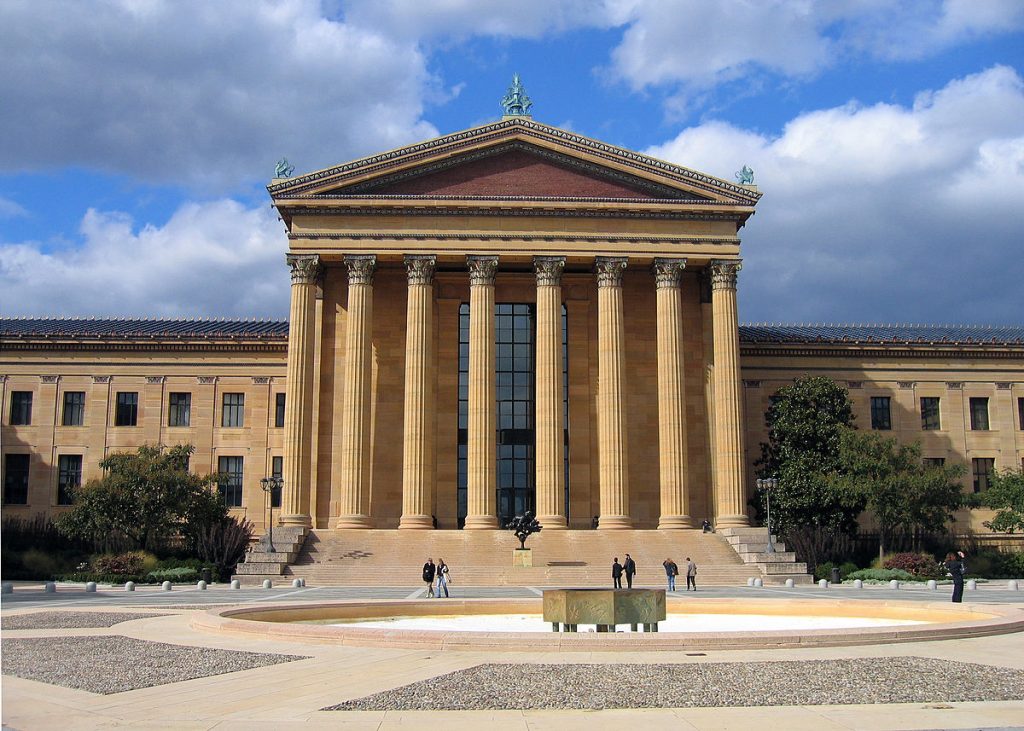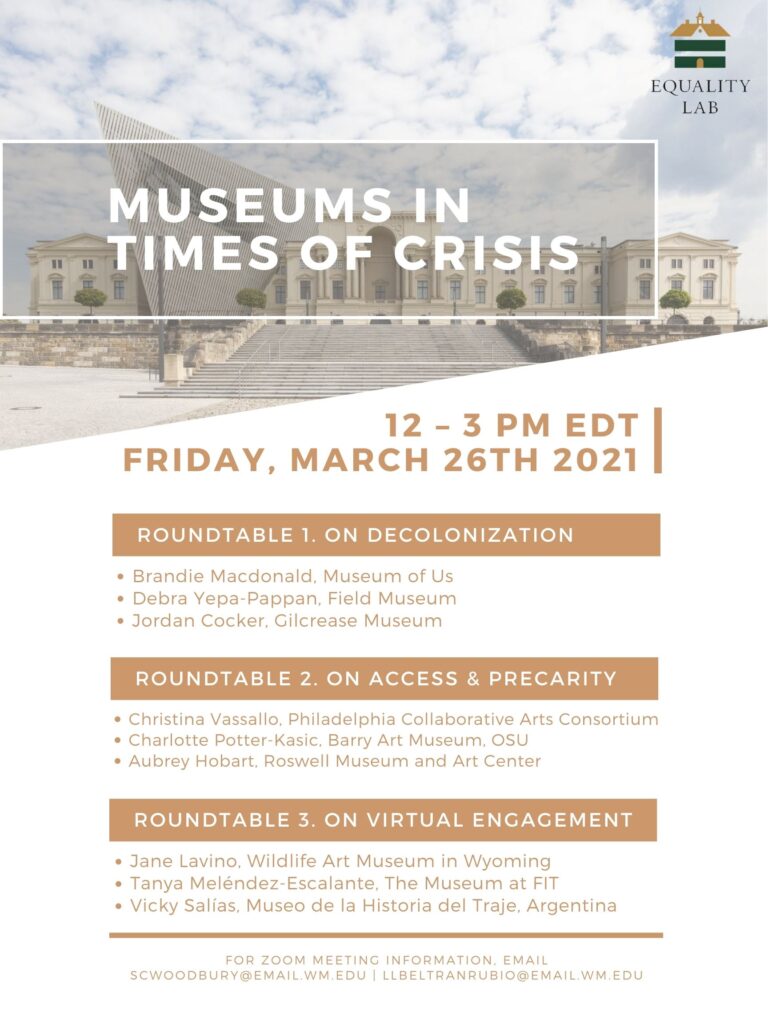Since coming to William & Mary, I’ve been able to participate in a variety of assistantships. Whether I’ve been inventorying maps at the Mariners Museum, organizing virtual conferences with the Equality Lab, or guiding students with career readiness at the Cohen Career Center, I’ve been able to expand my professional experiences while approaching the work I like to do through different lenses. This year, I’m embarking on a new journey by teaching AMST 470, Museums and Crisis.

This isn’t my first time in the classroom. I TA’d for Art History 101 and 102 as a Master’s student at Williams. During my time in Roswell, I organized and taught a weekend workshop on relief printmaking, which included a lecture, an interactive tour of a print exhibition I had curated, a demonstration of carving and printing techniques, and hands-on time in the studio. Since being at William & Mary, I’ve served as a classroom instructor for the Keio/W&M program, as well as a TA for the course “Utopia in the Americas.” This year’s assistantship, however, is different for two reasons. First, it’s the first time I’ll be teaching a semester-long course. Second, this is a semester-long class I’ve designed, from the reading selections to the kinds of assignments I’ve chosen to assess progress. In short, it’ll be the most involved teaching experience I’ve had to date.
Museums and Crisis isn’t the first course I’ve proposed to the American Studies Program. Since all AMST graduate students can teach once they’ve TA’d for one semester and passed their exams, I was eligible by the beginning of my third year. At the end of the 2020-2021 year then, I submitted a proposal for a 200-level course on museums and tourism. For this course, I was going to look at the history of museums through the lens of tourism, and consider how twentieth-century developments like the Harvey hotels, automobile culture, and other trends in travel and leisure have influenced the development of museums. While the faculty all liked the proposal, I didn’t get to teach the class because there weren’t enough slots for all graduate proposals, and priority went to the students entering their fifth year of funding. Instead, I was assigned to the Career Center, where I had a deeply engaging, rewarding experience (plus I got to go to Scotland, so I did great last year when it came to assistantships!).
Since I’m entering my fifth year, however, my advisor and other faculty told me that I’d most likely be teaching this year, and to submit a proposal. While my first instinct was to revise and resubmit the Museums and Tourism proposal, I instead started developing a new, upperclassmen seminar centering on museums and the various crises they have faced in recent years, both within the institution and in the world at large. My main inspiration was the symposium I co-organized at the Equality Lab with Laura Beltrán-Rubio, “Museums in Times of Crisis.” I remembered how engaging it had been to provide a space for museum professionals and activists to come together and talk about their experiences, and started wondering what that might look like as a course. Early versions of the proposal took a historical approach to the topic of museums of crisis, and my intent was to show how Progressivism, the Great Depression, the Cold War, the Civil Rights Movement, and other events had shaped the development of museums. As I started developing the course in earnest, however, I decided to focus on contemporary issues, as I realized there was more than enough happening right now to fill an entire course. Instead of focusing on the past, as I so often do in my scholarship, I decided to make the class an opportunity to confront the present.

Over the course of the semester, then, we’ll explore decolonization, systemic racism, climate change, and other topics. Although I’ve put together the reading and media lists, I see myself as a fellow learner rather than the final authority on the topics we’ll discuss. As with my curatorial work, I prefer the team leader model to a more top-down authority, and I’ll be learning alongside the students.
I’m also encouraging the students to contribute to the course content. While I’ve identified topics and material for the entire semester, I’m going to leave the syllabus open-ended for the first week of class so that students can express any preferences they have in terms of discussion topics. They’ll get to see a completed syllabus, of course, but I’ll let them know that the discussion topics can change if they prefer to focus on different subjects. If students show a strong preference for topics like disability studies, for instance, or labor, or something else, I’ll revise the syllabus to reflect their interests. There’s no way we can address every crisis affecting museums in one semester, but I can at least make sure we’re discussing the issues that are most urgent to them. They’ll also have the opportunity to explore different topics through their research projects, which I’m leaving pretty open-ended in terms of topics. The introductory unit will stay the same because I want to make sure students have a basic understanding of museums before we begin dissecting them, but the other topics are subject to change.
In addition to providing a space to talk about museums and crisis, I’m also planning on using this course to model peer feedback. This developed out of my own experiences. I’ll be honest: it took me a really long time to understand the benefits of peer review. As an undergraduate with imposter syndrome, I didn’t feel comfortable showing unfinished work to anyone. Even drafts of papers I shared with professors were pretty well polished because I didn’t want to be seen as incompetent. At Williams, I worked in isolation, with the only people ever reading my work being the professors themselves, usually in final draft form. It wasn’t until we were working on our capstone symposium presentations that I finally participated in peer review of any kind, and my work definitely benefitted from my colleagues’ insights. Subsequent experiences with writing groups, peer-reviewed journals, and exhibition proposals have only reinforced the benefits of getting feedback on in-process work. As I mentioned in a recent dissertation post, I’ve started sharing completely unedited chapter drafts with my advisor, something I wouldn’t have dreamed of doing back in college. If anything, I wish I’d gotten comfortable with it sooner, as I could have saved myself a lot of long working nights as I tried to anticipate every scholarly problem myself.
For this course then, I’ve built in workshops throughout the semester so that students can review one another’s work from start to finish. Partly this is to help ensure that students stay on schedule and not try to write everything at the last minute, but I also want to give them the opportunity to practice giving as well as receiving meaningful critiques. Regardless of what kind of fields they want to enter after graduation, peer critique is important, and I want them to have the chance to develop and refine that skill.
Over the course of the semester, I’ll provide periodic updates on the class. Regardless of how it goes, it should be a memorable experience. So long as the students get something worthwhile out of it, I’m doing okay.